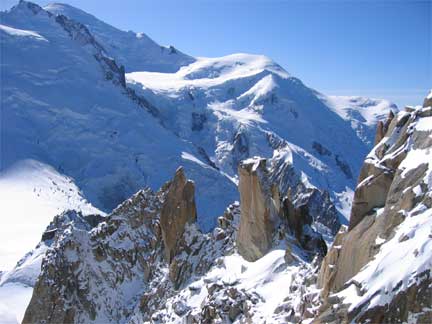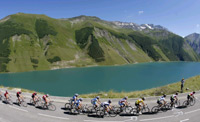Global climate change - French Alps
Hard to make the global local in the Alps
by Sarah Elzas
Article published on the 2009-11-19 Latest update 2009-12-04 15:51 TU

View of the Mont Blanc from the Aiguille du Midi mountain peak, October 2009
(Photo: Sarah Elzas/RFI)
Suzy Duvillard has an ecological streak.
Over the years she has been refurbishing, her 12-room Hôtel La Demi-Lune with "green" materials.
La Demi-Lune is in the French Alps near Mont Blanc, Europe’s highest mountain.
“We have totally decorated with reused wood,” Duvillard says proudly, showing off the dining area’s beams, which used to be part of another restaurant’s terrace.
Downstairs is a newly-renovated apartment, redone with natural paint and equipped with low-wattage bulbs. The hotel's clients are encouraged to recycle by little notes posted around the hotel. They also remind them to turn off lights, and take the bus, rather than a car, into town.
Duvillard is the president of Mont Blanc Ecotourisme, an association of hotels, restaurants and businesses, whose focus is very local: encouraging the use of public transportat, recycling plastic water bottles and reusing rainwater, for example.
These are small acts of environmentalism, which Duvillard says are part of keeping the countryside beautiful. However, she has trouble connecting it to climate change.
Temperatures in the area are expected to rise an average of two to three degrees over the next decades, but Duvillard cannot see the evidence at the moment.
“We’ve had wonderful snowfalls lately, so it’s hard to say, ‘Oh, it’s the heating of the atmosphere’,” she says. “We have cycles of winters.”
For many people who work in the tourism industry, which thinks season-to-season, rather than long-term, talk of global warming does not always jive with what they see out the window.
But researchers have been finding more and more evidence that rising temperatures are changing the landscape.
Up in the high mountains, above 2,500 metres, where things are almost always frozen solid, researchers are finding definite changes as the weather gets warmer.
A group of European permafrost researchers has been measuring and tracking temperatures in the high Alps. They have found a correlation between rising temperatures and rock falls.
Permafrost is anything that stays below zero degrees for two years or more. Water in permafrost is ice, acting like cement that holds boulders in place. If permafrost thaws, the ice melts, and rocks fall. Researchers have documented more frequent rock falls in recent years.
“We have all kinds of techniques to measure rock falls and the evolution of permafrost and all that is correlated,” explains French permafrost researcher Ludovic Ravanel. “We no longer have any doubt between the connection of global warming and rock falls.”
Rock falls are dangerous for mountain climbers, and larger ones can threaten towns at the base of mountains. Thawing permafrost can destabilise ski-lifts and mountain transport systems.
The researchers measuring the evolution of permafrost around Mont Blanc are convinced that human activity has hastened global warming.
But, regardless of the cause, the result is the same. The landscape is changing, and towns that depend on winter tourism will have to rethink their business models.
In the mid-mountain, below 2,500 metres, ski resorts have to worry about snow, or the lack of it. Some are looking ahead.
“We want to develop the summer more,” says Bruno Clément, the tourist office manager for the Saisies ski resort. Recognising that the cold winters may not be the norm in the coming years, he says the resort is focusing on non-winter activities, like a new toboggan-style rollercoaster down one of the hills, which can be used in the winter or summer.It is still unclear how the climate in the French Alps will evolve over the next few years. As average temperatures rise, that could result in much hotter summers, like the summer of 2003, and much colder winters.
But everyone will have to adapt.
“I think that what we have to do in the next 50 years is finding how we can get by with it … seeing how we can cope with the effects of global warming,” says German permafrost researcher Michael Krautblatter. “We will see the real effects of what we’ve done in the next ten or 20 years.”






